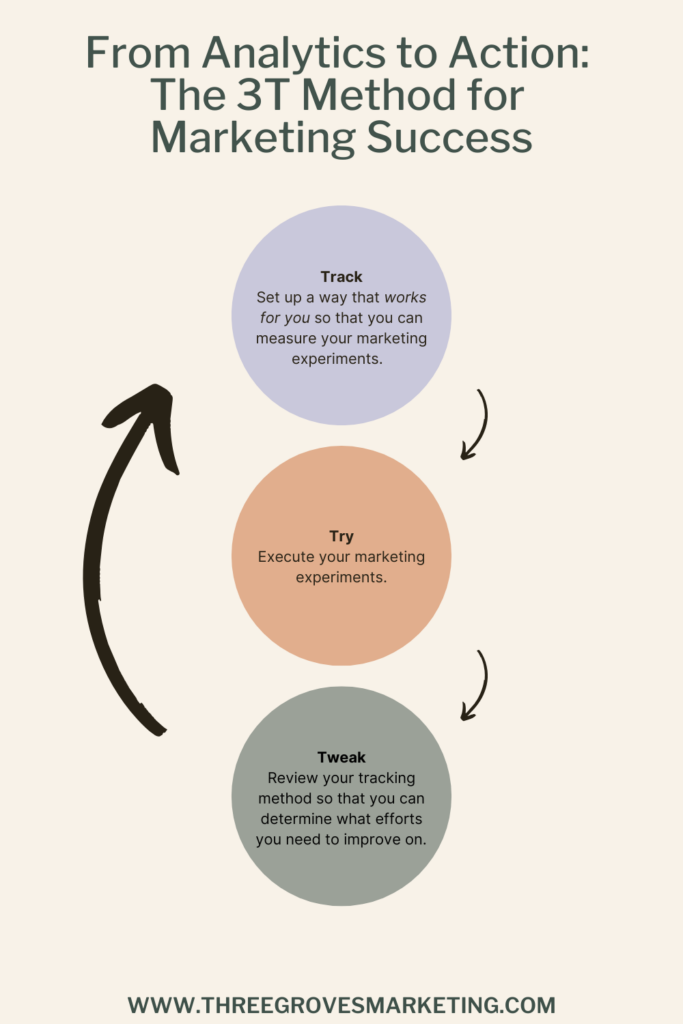As a business owner, there are tons of ways to market your business. From allll the social media platforms, email newsletters, blogging, vlogging, and the next new thing that the world will throw at us, it’s easy for a large portion of your time to get scooped up into all of those things.
And I get it – marketing IS one of the most important things that you can spend your time on as a business owner. You want to put yourself out there so that people get to know you and become aware of the products or services you provide.
But after putting in all of that effort, wouldn’t it be such a bummer if you weren’t actually sure which marketing efforts you’re spending all of your time, energy, and money on are working?!
In my opinion, only focusing on marketing efforts that make sense and work for you specifically is a much better use of time, as it allows you to do more of what’s working and confidently leave the rest behind!
So, how do you know what’s working? By measuring your marketing efforts! And the best way to do that is by setting up and using a personal marketing analytics dashboard.
What qualifies as a marketing analytics dashboard?
Because it’s important to operate in a space that makes the most sense for you as a human, what you use for your marketing analytics dashboard might look a bit different than your biz besties.
Maybe you choose to record your marketing experiments like a story in a journal?
Maybe you choose to record your marketing experiments in a spreadsheet?
Or maybe you’d like to have an automated marketing analytics dashboard?
As long as the marketing analytics dashboard that you’ve set up allows you to track your marketing experiments you are good to go!
Recording your data is wonderful, but taking action is the juice!
Using the 3T Method to answer the question, “How do I know if my marketing is working?”
The 3T method is my 3 step method to taking action on your marketing data!
The first step is to track – you’ll need to set up a way that works for you so that you can measure your marketing experiments.
The second step is to try – this is where you execute your marketing experiment.
The final step is the tweak – by reviewing your tracking method you can determine what tweaks you need to make to improve on your last experiment, so that you can try again!
Notice how the process is cyclical.



Track: Identify and Record the Key Performance Indicators (KPIs) for Your Business
Your marketing analytics dashboard should reflect all the things you need to determine if your marketing is working.
Things that are directly related to your ability to make data driven business decisions.
Some of those things might include:
- Where your website traffic is coming from
- What conversion events are happening on your website
- What your most visited website pages are
- Which keywords are driving traffic to your website
- Lead funnel traffic sources and conversion rates
- Sales traffic and conversion sources with conversion rates
If you still aren’t sure which marketing metrics will allow you to make better business decisions check out this blog! It’ll help you determine which 4 marketing metrics matter most to your business.
Try: Setup and Complete Marketing Experiments in Your Business
This is the phase of the three step process that is often the hardest.
Why? Because trying is hard (even though we don’t talk about it often enough)
Here is where you will implement your marketing experiment.
You’ll complete the steps you’ve laid out for yourself and you’ll keep going for the time that you’ve allotted (remember, this is your experiment) whether or not you can tell if your marketing efforts are working.
It’s important to see your marketing experiment through so that you can separate facts from feelings – you’ll use all of your data to determine if you marketing experiment worked inside of the final step of the 3T Method – Tweak.
Tweak: Making Data-Driven Decisions
Here are a few of the things I like to do when I’m determining how to tweak my marketing experiments.
Notice patterns – what first jumps out at me?
This is one of the most important reasons why you want to store your data in a way that works with your brain.
Can you draw patterns by looking at flat data? Maybe a spreadsheet would work for you.
Or do you need a visual representation of the numbers? You might need some charts, friend!
Figure out what created the shift in the pattern.
What marketing efforts, or lack of, attributed to the shift in pattern?
Did something happen that caused the business to gain traction?
Did some things get skipped?
Make a plan to impact the pattern.
This is better explained with some examples:
- Maybe you notice that your email subscribers went up and you figure out that you shared on your stories on the days you saw email subscriber spikes. Your plan to continue the positive pattern might be that you show up on stories more during the next time period you are tracking, or maybe you think about people you could engage with to do a story swap.
- Maybe you notice your email open rates were lower than you’d like. You emailed your list once a week, but upon further investigation you realize your subject lines.. mighta been a bit stale. Your plan to increase your open rates during the next time period that you are tracking could be
- Brainstorm snappier subject lines
- A/B test them inside your email service provider so that you have twice the data to draw from next tracking period.
Integrating the 3T Method into Your Marketing Analytics Routine
The application of the 3T Method will be determined by the cadence of your marketing experiments.
You’ll cycle through each of the steps – Track, Try, and Tweak at a pace that makes sense for you using the KPIs you’ve determined are applicable for your business to make better business decisions.
So whaddya say? Are you reading to create your own Marketing Analytics dashboard so you can clearly understand which marketing efforts are working in your business?
If so, I’m here to help!


leave a comment